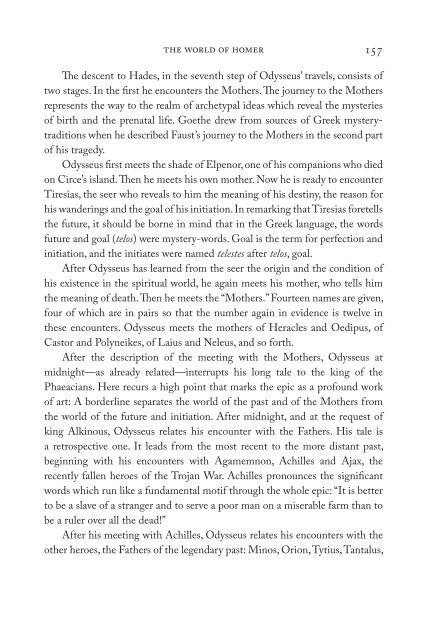The Gospel of Hellas - Research Institute for Waldorf Education
The Gospel of Hellas - Research Institute for Waldorf Education
The Gospel of Hellas - Research Institute for Waldorf Education
Create successful ePaper yourself
Turn your PDF publications into a flip-book with our unique Google optimized e-Paper software.
the world <strong>of</strong> homer<br />
<strong>The</strong> descent to Hades, in the seventh step <strong>of</strong> Odysseus’ travels, consists <strong>of</strong><br />
two stages. In the first he encounters the Mothers. <strong>The</strong> journey to the Mothers<br />
represents the way to the realm <strong>of</strong> archetypal ideas which reveal the mysteries<br />
<strong>of</strong> birth and the prenatal life. Goethe drew from sources <strong>of</strong> Greek mysterytraditions<br />
when he described Faust’s journey to the Mothers in the second part<br />
<strong>of</strong> his tragedy.<br />
Odysseus first meets the shade <strong>of</strong> Elpenor, one <strong>of</strong> his companions who died<br />
on Circe’s island. <strong>The</strong>n he meets his own mother. Now he is ready to encounter<br />
Tiresias, the seer who reveals to him the meaning <strong>of</strong> his destiny, the reason <strong>for</strong><br />
his wanderings and the goal <strong>of</strong> his initiation. In remarking that Tiresias <strong>for</strong>etells<br />
the future, it should be borne in mind that in the Greek language, the words<br />
future and goal (telos) were mystery-words. Goal is the term <strong>for</strong> perfection and<br />
initiation, and the initiates were named telestes after telos, goal.<br />
After Odysseus has learned from the seer the origin and the condition <strong>of</strong><br />
his existence in the spiritual world, he again meets his mother, who tells him<br />
the meaning <strong>of</strong> death. <strong>The</strong>n he meets the “Mothers.” Fourteen names are given,<br />
four <strong>of</strong> which are in pairs so that the number again in evidence is twelve in<br />
these encounters. Odysseus meets the mothers <strong>of</strong> Heracles and Oedipus, <strong>of</strong><br />
Castor and Polyneikes, <strong>of</strong> Laius and Neleus, and so <strong>for</strong>th.<br />
After the description <strong>of</strong> the meeting with the Mothers, Odysseus at<br />
midnight—as already related—interrupts his long tale to the king <strong>of</strong> the<br />
Phaeacians. Here recurs a high point that marks the epic as a pr<strong>of</strong>ound work<br />
<strong>of</strong> art: A borderline separates the world <strong>of</strong> the past and <strong>of</strong> the Mothers from<br />
the world <strong>of</strong> the future and initiation. After midnight, and at the request <strong>of</strong><br />
king Alkinous, Odysseus relates his encounter with the Fathers. His tale is<br />
a retrospective one. It leads from the most recent to the more distant past,<br />
beginning with his encounters with Agamemnon, Achilles and Ajax, the<br />
recently fallen heroes <strong>of</strong> the Trojan War. Achilles pronounces the significant<br />
words which run like a fundamental motif through the whole epic: “It is better<br />
to be a slave <strong>of</strong> a stranger and to serve a poor man on a miserable farm than to<br />
be a ruler over all the dead!”<br />
After his meeting with Achilles, Odysseus relates his encounters with the<br />
other heroes, the Fathers <strong>of</strong> the legendary past: Minos, Orion, Tytius, Tantalus,

















